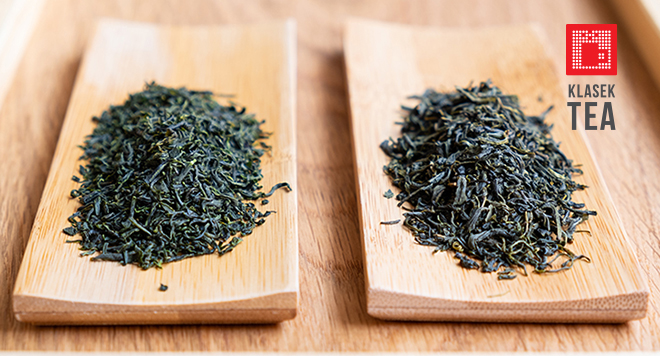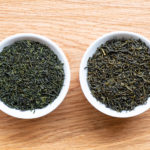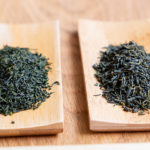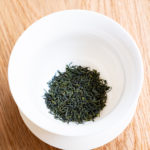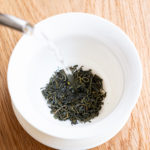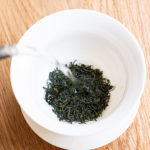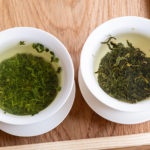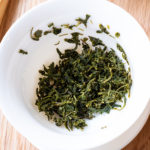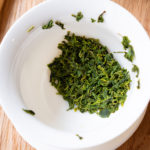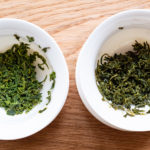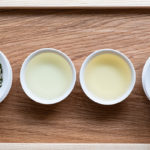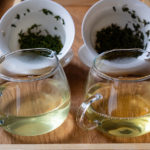We are often asked about the green Korean teas we offer. What is the difference between them? What makes them special compared with other green teas? Why are they so expensive? In this review, we will introduce these teas to you and answer the questions we get the most frequently.
What is Nokcha and when it is harvested
We chose two green teas that were harvested this spring – Nokcha Gamnong and Nokcha Sejak Haenam. For Korean teas, the spring harvest is the most important, and in most cases the only one. Nokcha is “green tea” in Korean. The word Gamnong means “Sweet Harvest”, a poetic name the producer gave to this particular tea. The word Sejak in the name of the second sample means “thin sparrow tongue”; it denotes a spring flush that takes place after Gok-u (meaning “grain-rain”, 20th/21st April) and before Ipha (“advent of summer” 5th/6th May). This is the time when the first or second flush of the best quality young leaves are picked. This usually includes a bud and two top leaves. Second-flush teas have a fuller and more distinctive taste than the Ujeon first-flush ones.
Different growing regions
Both the teas were picked in the early spring and both can be denoted as Nokcha Sejak. What is the difference then? They come from different areas. Nokcha Gamnong was grown at the Jangsung Tea Plantation, which is 200 metres above sea level. The garden was founded in 1965 and its tea shrubs are up to 50 years old. It is completely operated as a certified organic plantation. Its height, combined with the location in the northernmost part of the Jeolla-namdo province, means a very cold and moist climate, which is ideal for tea growing. On the other hand, Nokcha Haenam grows in the very south of the Korean peninsula, a stone’s throw from the ocean. The cool sea breeze and high humidity from frequent precipitation are great for tea plants in this area.
Tea processing – between China and Japan
Another difference is the processing of the leaves. In both cases, the oxidation of the enzymes contained in the leaves was ended by steaming, a practice common in Japan. Also, they were both rolled when hot to let out as much juice as possible. While in Gamnong the emphasis was on preserving the juicy green grassy taste, typical for the unprocessed leaves growing on the shrubs, The Haenam leaves were baked slightly longer in the final phase of processing, which gave them a pleasantly oily to roasted taste.
The connoisseurs of Japanese green teas will prefer Nokcha Gamnong as it has fresh, grassy tones full of the scent of seaweed, citruses, green pepper, and basil, while the fans of Chinese green teas will probably reach for Nokcha Haenam, appreciating its slight oiliness and the taste of roasted nuts and pumpkin seeds.
South Korean teas are a notional bridge between Chinese and Japanese green teas – historically, because of their processing and taste. When transported from China to Japan, teas always traveled through the Korean peninsula. This was the beginning of their growing, processing and drinking began in the area. However, tea-growing experienced many difficulties during Korean history, which is why the beginning of the 20th century saw the last few remaining tea gardens. It was the Japanese occupation and post-WWII time that brought some serious development of tea growing. Still, the production of truly high-quality green teas is very limited. This is the reason why the prices of Korean green teas are so much steeper than the prices in neighboring Japan and China.
Should you like to read more about Korean tea, do delve into the book Korean Way of Tea.
2021 Nokcha Gamnong
In Korean, Nokcha means green tea, and Gamnong means “Sweet Harvest“. It is a hand-picked spring harvest that took place right before and after the Gok-u feast (grain-rain, around 20th April), which is a time between the Ujeon (“before rain”) first flush and the Sejak (“thin sparrow tongue”) second flush. It was processed by the wet method, where the oxidation of the enzymes is interrupted by hot steam.
Dry, regularly rolled tiny dark green tips with the juicy smell with citrus tones. Light green infusion with creamy to oily taste with fine fruity sweetness and the tones of basil, citruses, and meadow flowers.
Nokcha Sejak Haenam 2021
Korean green tea Nokcha picked from the Yabukita tea shrubs in late April 2021 in the very south of the Korean peninsula, within view of the nearby ocean. The cool sea breeze and high humidity from frequent precipitation are great for tea growing in this area.
Tiny regularly rolled dry leaves with distinctively sweet creamy vanilla fragrance and a sharp trace of green pepper. Bright green infusion with exquisitely balanced full, smooth and creamy taste with a trace of mulberries.
Preparation: Steep 1 teaspoon (4 g) of tea in 200 ml of boiled water cooled to 65–70 °C for 1 minute. Allows for more infusions prepared similarly, gradually raising the water temperature.

